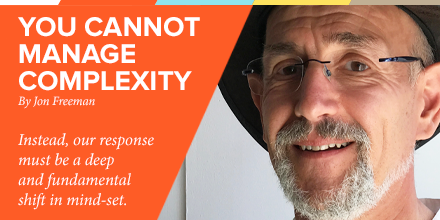Why does change happen? Fundamentals of development

Stupid question maybe? Because change just does? Does it even matter why?
OK, I will ask another way.
The fundamental basis of Reinventing Organizations and “Teal” is that humanity has progressed through stages of development, or “consciousness”. So why are we not still in Amber/Blue and why might Teal be coming? Because Ken Wilber says so? Yes, he says so, but Ken never says anything without a reason or three.
His reasons lie in the research of Professor Clare W. Graves, and the theories that Graves developed, which later got branded as Spiral Dynamics (SD). What Wilber saw there, and for a while described as “The theory that explains everything”, were the reasons, not only why humans/organisations/societies change, but the patterns that drive how they change. And it matters because those patterns enable us to see what is happening, and to influence it for ourselves and others.
I’m not just presenting my own view. I quote from a recent e-mail by Dr Don Beck: “Graves’ work is really about change rather than static systems or types.” As the person Ken Wilber learned SD from, he should know.
Behind each change is a developmental tension without which things would, and should, stay as they are.
If everything is as it should be, why wouldn’t we simply enjoy the heck out of it? We are in turbulent times, and maybe we forget that human history has had long periods of stability. Like biological evolution, it isn’t continuous. There are plateaus and there are leaps. As with biology, change is often an adaptive response to shifts in conditions.
Emergence is not a sequence of inevitable steps. There might indeed be a next stage on Graves’ map that inspires us, but the map is not the territory, and there is no certainty that humanity will not simply regress or collapse. If you don’t recognise that possibility, you haven’t been observing the news. Switching the metaphor, the baby could be stillborn if we cannot midwife its birth.
Change happens in the world and calls for change from us. We are inclined to talk of “emergence”, and there is indeed a natural trajectory as life gets more complex. That natural trajectory is as true of ecologies and organisations as it is of socio-psychological reality. But don’t let that truth fool you. There are two connected strands in play, like the double helix on which Graves modelled the theory. The conditions for existence, that which surrounds us, make one strand. The conditions of existence, the ways in which humans experience their internal reality, might shift in response to an external change—or they might not.
If we don’t understand what generates, inhibits or disrupts change, we are ill-equipped to support others—individuals, organisations or societies—in their developmental process. We might even accelerate their collapse.
How do we know whether an organisation is ready to change and whether it has the capacity to execute what it needs? How does it discover just what change is naturally next for it? Does it need small, incremental steps, or a revolutionary shift?
A theory should do three things. It should explain what is already happening and it should predict what is likely to happen as conditions change. But it only becomes truly powerful if it enables us to intervene. Knowing Newton’s laws of motion falls well short of being able to apply his theory to aircraft design.
Personal, organisational and societal changes don’t merely happen. Yes, there are accidents and natural dynamics, but there are also choices and decisions. Those of us who work as facilitators, coaches and organisational design professionals, and those of us who lead organisations, are agents of that change. We make choices of what to think and do. And since the external conditions for existence influence the choices that others will make, we also have the possibility to change the exteriors so as to support others to change too. When you want a plant to grow, you don’t just select the right seed; you also work on the soil and the availability of light and water.
Potentially, if we so choose, we are agronomists of the human growth milieu, farmers of the human herd, stewards of socio-psychological ecosystems.
Why wouldn’t we want to know as much as we possibly can about the natural design laws, the systems science that describes the arena we are working in? My belief that this is needed. My expectation that others will want it, is what propels me to write about Spiral Dynamics and to teach the many tools and techniques it brings in support of our work. The fact that the theory is endlessly interesting and always developing is one bonus. The way that it spins off into insights about every aspect of my existence is another.
The theory is not dry and academic. It touches our emotions and challenges our personal boundaries. It contains eye-opening and mind-awakening realisations for everyone —more than I know how to convey. After more than a decade, I continue to see the world in new ways on a regular basis, because I have learned a new way of seeing.
Originally posted 17 Mar 2017.
Politics, climate, markets – we a living in a uncertain and changing world. What do you think the “developmental tension” is behind global change and how does that impact the choices and decisions you make on a daily basis, personally and/or professionally? Add your perspective as a comment below.




Leave a Reply